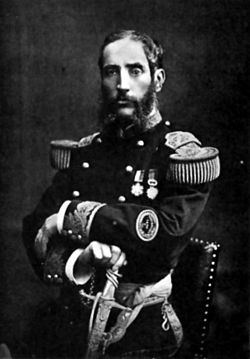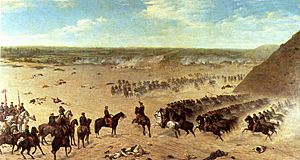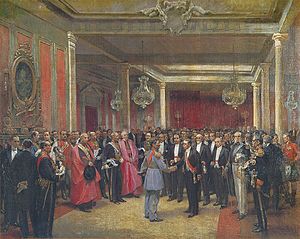Andrés Avelino Cáceres facts for kids
Quick facts for kids
Andrés Avelino Cáceres
|
|
|---|---|
 |
|
| 27th and 30th President of Peru | |
| In office August 10, 1894 – March 20, 1895 |
|
| Vice President | César Canevaro Cesáreo Chacaltana Reyes |
| Preceded by | Justiniano Borgoño (Interim President) |
| Succeeded by | Manuel Candamo (President of the Provisional Government) |
| In office June 3, 1886 – August 10, 1890 |
|
| Vice President | Remigio Morales Bermúdez Aurelio Denegri |
| Preceded by | Antonio Arenas (President of the Provisional Government) |
| Succeeded by | Remigio Morales |
| Second Vice President of Peru | |
| In office March 12, 1881 – November 6, 1881 |
|
| President | Francisco García Calderón |
| Preceded by | Vacant (last held by José Francisco Canevaro in 1879) |
| Succeeded by | Vacant (Aurelio Denegri elected in 1886) |
| Senator from Callao | |
| In office July 28, 1901 – October 25, 1906 |
|
| Senator from Ayacucho | |
| In office July 28, 1894 – August 10, 1894 |
|
| Member of the Chamber of Deputies | |
| In office July 28, 1892 – July 28, 1893 |
|
| Personal details | |
| Born | November 10, 1836 Ayacucho, Peru |
| Died | October 10, 1923 (aged 86) Lima, Peru |
| Nationality | |
| Political party | Constitutional Party |
| Spouse | Antonia Moreno Leyva |
| Children | 3 |
| Military service | |
| Allegiance | |
| Branch/service | |
| Years of service | 1854-1901 |
| Rank | Marshal |
| Battles/wars | Peruvian Civil War of 1894-1895 War of the Pacific Peruvian Civil War of 1884-1885 |
Andrés Avelino Cáceres Dorregaray (born November 10, 1836 – died October 10, 1923) was a famous Peruvian general and politician. He served as the President of Peru two times. His first term was from 1886 to 1890, and his second was from 1894 to 1895. In Peru, he is seen as a national hero. He bravely led the fight against Chilean forces during the War of the Pacific (1879–1883).
Contents
Early Life and Military Start
Andrés Avelino Cáceres was born on November 10, 1836, in Ayacucho, Peru. His father was a landowner, and his mother was the daughter of a Spanish colonel. Cáceres had a mixed heritage, including Inka-Wanka ancestry. He went to school at the Colegio San Ramón in his hometown.
In 1854, Cáceres stopped his studies to join the army. He became a cadet in the Ayacucho Battalion. He quickly rose through the ranks, becoming a Second Lieutenant in 1855 and a Lieutenant in 1857. He was wounded in his left eye during a rebellion in 1857-1859.
Fighting Against Spain
In 1865, Cáceres strongly disagreed with President Juan Antonio Pezet. Pezet had allowed Spain to take over the Chincha Islands. Because of his protests, Cáceres was sent away to Chile. However, he and other officers escaped and returned to Peru.
They joined a revolution against Pezet's government. Cáceres helped take over Lima. Later, he fought in the Battle of Callao on May 2, 1866. This battle forced Spanish ships to leave Peruvian waters.
A Break from the Army
In 1868, Cáceres decided to leave the military. He went back to Ayacucho to become a farmer. But he returned to politics in 1872. He opposed a coup (a sudden takeover of government) against President Manuel Pardo. Pardo was Peru's first civilian president.
Cáceres's support for Pardo helped him become the head of the Zepita Battalion. In 1874, he stopped a rebellion led by Nicolás de Piérola. For this, he was promoted to colonel and later became the prefect (a high-ranking official) of Cuzco.
The War of the Pacific (1879–1883)
The War of the Pacific began on April 5, 1879. Cáceres and his Zepita Battalion were sent to the Tarapacá province. He fought bravely against the Chilean Army in the battles of San Francisco and Tarapacá. In the Battle of Tarapacá, his actions were key to Peru winning, even though they were outnumbered.
Despite this win, the Peruvian Army could not stop the Chilean invasion. They had to retreat north to Tacna. Chilean forces landed further north and attacked the main Peruvian positions.
Cáceres helped reorganize the Peruvian Southern Army. This army, along with a Bolivian army, was positioned around Tacna. However, political problems in Peru made it hard for the combined forces to fight effectively.
On May 26, 1880, the Battle of Tacna took place. The Chileans defeated the combined army. Cáceres played a big part in this battle before retreating to Lima.
Defending Lima
President Piérola ordered the remaining army to defend the capital, Lima. Many citizens, though poorly armed, joined the fight. Cáceres was put in charge of a division of the Reserve.
With no help coming, and the Chilean army attacking from the south, Peruvian forces were defeated. This happened in the battles of San Juan and Chorrillos and Miraflores. Cáceres was wounded in the Battle of Miraflores. When Lima fell in January 1881, he escaped to Jauja in the mountains of Peru.
The Andes Warlock: La Breña Campaign
As the highest-ranking officer in the region, Cáceres became the military leader of the central departments on April 26, 1881. He started organizing a resistance movement against the Chilean occupation. He led a guerrilla war, getting local farmers to join him.
Because of the support from locals, the difficult mountain terrain, and his own military skills, Cáceres defeated several Chilean groups. He won battles at Pucará (twice), Marcavalle, and La Concepción.
For these amazing feats, people called him the Brujo de los Andes (The Andes Warlock). But even with all his skill, he was finally defeated by the better-equipped Chilean forces at the Battle of Huamachuco on July 10, 1883. After this, a Peruvian government led by Miguel Iglesias signed the Treaty of Ancón on October 10, 1883. This treaty ended the war and recognized Peru's defeat.
First Presidency (1886–1890)
After the war, Cáceres refused to accept Iglesias as president. This led to a civil war between their groups. Cáceres avoided the enemy army and attacked Lima on November 28, 1885. This forced Iglesias to resign.
Cáceres ran for president with the Constitutional Party and won. He became president on June 3, 1886. His government faced a huge economic crisis. Peru had a massive debt and its economy was badly damaged by the war.
To solve these problems, Cáceres's government negotiated with its creditors. This led to the Grace Contract, signed on October 28, 1888. Under this agreement, Peru gave control of its railways and a guano (bird droppings used as fertilizer) concession to its creditors. In return, the creditors agreed to pay off Peru's debt and expand its railways.
The Grace Contract caused a lot of debate. Some people accused Cáceres of selling off Peru's assets too cheaply. However, the agreement helped Peru solve its external debt problem and allowed for railway expansion when the country had no money for it. Cáceres finished his term and handed power to his successor, Remigio Morales Bermúdez, on August 10, 1890.
Second Presidency (1894–1895)
President Morales Bermúdez died in office on April 1, 1894. Justiniano Borgoño, the Vice President, took over. New presidential elections were held, and Cáceres won again. But many people said the election was unfair. He started his second term on August 10, 1894.
Soon, rebellions broke out across the country. These groups united under the leadership of former president Nicolás de Piérola. Rebel forces attacked Lima on March 17, 1895. The fighting stopped two days later when a truce was signed. Cáceres realized he had lost support and resigned. An interim government took over.
Later Years
After leaving office, Cáceres lived in Buenos Aires, Argentina, from 1895 to 1899. He returned to Peru but later went to Europe. There, he served as Peru's ambassador to Italy (1905–1911) and Germany and Austria–Hungary (1911–1914).
Back in Lima, he supported Augusto B. Leguía for president. Leguía successfully took power in 1919. The new government honored Cáceres by giving him the rank of Marshal on November 10, 1919. Andrés Avelino Cáceres passed away on October 10, 1923, in Ancón at the age of 86.
Legacy
In Peru, Cáceres is seen as a great national hero. He represents strength and resistance against foreign forces. This is because he opposed Spain's takeover of the Chincha Islands. More importantly, he organized the brave resistance against Chile during the War of the Pacific.
Today, a group of Peruvian military veterans are called etnocacerista after Cáceres. They are a big part of the support for the Peruvian Nationalist Party.
His daughter, Zoila Aurora Cáceres, also left behind many important writings.
See also
 In Spanish: Andrés Avelino Cáceres para niños
In Spanish: Andrés Avelino Cáceres para niños



